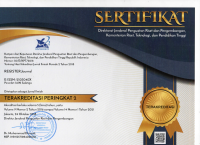Let the Game Begin: Ergodic as an Approach for Video Game Translation
Abstract
This paper attempts to propose ergodic as an approach for video game translation. The word approach here refers to an approach for translation products and to an approach for the translation process. The steps to formulate ergodic as an approach are first, Aarseth’sergodic literature is reviewed to elicit a basis for comprehension toward its relationship with video games and video game translation Secondly, taking the translation of Electronic Arts’Need for Speed: Own the City, Midway’s Mortal Kombat: Unchained, and Konami’s Metal Gear Solid, ergodic based approach for video game translation is formulated. The formulation signifies that ergodic, as an approach for video game translation, revolves around the treatment of video games as a cybertext from which scriptons, textons, and traversal functions as the configurative mechanism influence the selection of translation strategies and the transferability of variables and traversal function, game aesthetics, and ludus and narrative of the games. The challenges countered when treating video games as a cybertext are the necessities for the translators to convey anamorphosis, mechanical and narrative hidden meaning of the analyzed frame, to consider the textonomy of the games, and at the same time to concern on GILT (Globalization, Internationalization, Localization, and Translation).
KeywordsErgodic ; Translation Approach; Video Game Translation ; Textonomy; Anamorphosis
Full Text:
PDFReferences
Aarseth, E. J. (1997). Cybertext: perspectives on ergodic literature. Johns Hopkins University Press
Baltimore, Maryland.
Bal, M. (2009). Narratology: Introduction to the theory of narrative. University of Toronto
Press. Toronto.
Bernal-Merino, M. Á. (2009). Video games and children’s books in translation.The Journal
of Specialised Translation, 11, 234-247. London.
Bogost, I. (2007). Persuasive games: The expressive power of videogames. Massachusetts Institute of Technology (MIT). Massachusetts.
Dietz, F. (2007). " How Difficult Can That Be?"-The Work of Computer and Video Game
Localization. Tradumàtica: traducció i tecnologies de la informació i la comunicació,
(5). Barcelona.
Esselink, B. (2000). A practical guide to localization (Vol. 4). John Benjamins Publishing. Amsterdam.
Fernández Costales, A. (2012). Exploring translation strategies in video game localization. Oviedo.
Frasca, G. (1999). Ludology meets narratology: Similitude and differences between (video)
games and narrative. Ludology. org. Helsinki.
Frasca, G. (2007). Play the message: Play, game and videogame rhetoric.Unpublished PhD
dissertation. IT University of Copenhagen, Denmark.
"Game." From Half-Real: A Dictionary of Video Game Theory. http://www.halfreal.net/dictionary/#game. (Accessed October 17, 2015.)
Huizinga, J., & Hull, R. F. C. (1949). Homo ludens. A study of the play-element in
culture.[Translated by RFC Hull.]. Routledge & Kegan Paul.Işığan, A. (2013). The
production of subject and space in video games. G| A| M| E Games as Art, Media,
Entertainment, 1(2).
Järvinen, A. (2002).. Gran Stylissimo: The Audiovisual Elements and Styles in
Computer and Video Games. In CGDC Conf.. California.
Jayemanne, D. (2009). Generations and Game Localization. Eludamos. Journal for Computer
Game Culture, 3(2), 135-147. Cambridge.
Juul, J. 2005. Half-real. Video Games between Real Rules and Fictional Worlds. Cambridge
(Massachusetts) und London. Oldenburg.
Mangiron, C., & O’Hagan, M. (2006). Game Localisation: unleashing imagination with
‘restricted’translation. The Journal of Specialised Translation,6, 10-21. London.
O'Hagan, M., & Mangiron, C. (2013). Game localization: translating for the global digital
entertainment industry (Vol. 106). John Benjamins Publishing. Amsterdam.
O’Hagan, M. (2009). Putting pleasure first: localizing Japanese video games.TTR:
Traduction, terminologie, rédaction, Vol 22(1), 147-165. Montréal.
Munday, J. (2008). Introducing translation studies . London and New York.
Nord, C. (2006). Loyalty and fidelity in specialized translation. Confluências: Revista de
Tradução Cientifica e Técnica, 4, 29-41. Barcelona.
Purnomo, S.L.A & Purnama, S.L.P. (2013). Penerjemahan Video Games. IAIN Press. Surakarta.
Purnomo, S. L. A. (2015). Grab the Garb: The Influences of Translation Techniques in the
Ludological Aspects of Video Game Translation (A Case Study of Square Enix’s
Lightning Returns: Final Fantasy XIII). IZUMI, 4(1), 1-9. Semarang.
Rush, J. (2005). The ergodic bridge. In MiT4: The Work of Stories. Fourth Media in
Transition conference (Cambridge, MA, 6-8 May 2005). Cambridge.
Sicart, M. (2011). The ethics of computer games. Massachusetts Institute of Technology (MIT). Massachusetts.
Simons, J. 2007. Narrative, games, and theory. Game studies, 7(1), 1-21. Copenhagen.
Trifonas, P. P. (2015). Crafting the literature of semiotic possibility: from the metaphysical to
the detective story in The Name of the Rose. In International Handbook of
Semiotics (pp. 239-264). Springer . Amsterdam. Netherlands.
Zimmerman, E., Perron, B., & Wolf, M. J. P. (2009). The Video Game Theory Reader 2. New York & London.
FIGURE REFERENCES
Need for Speed Carbon: Own the City is the property and trademark of Electronic Arts
Metal Gear Solid is the property of Konami
Mighty Final Fight is the property of Capcom
Mortal Kombat: Unchained is the property of Midway
DOI: https://doi.org/10.18326/rgt.v9i2.107-123
Refbacks
- There are currently no refbacks.
Copyright (c) 2016
License URL: https://creativecommons.org/licenses/by-sa/4.0/










